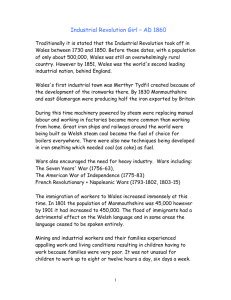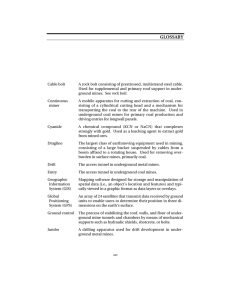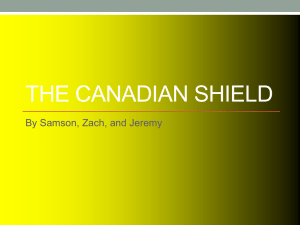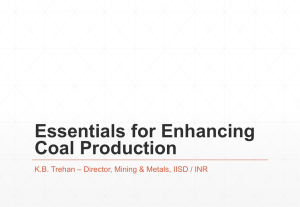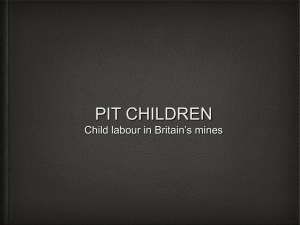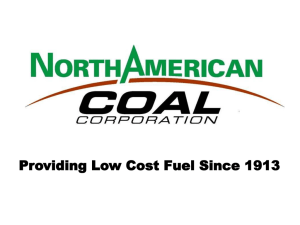LESSONS FROM PIKE RIVER
advertisement
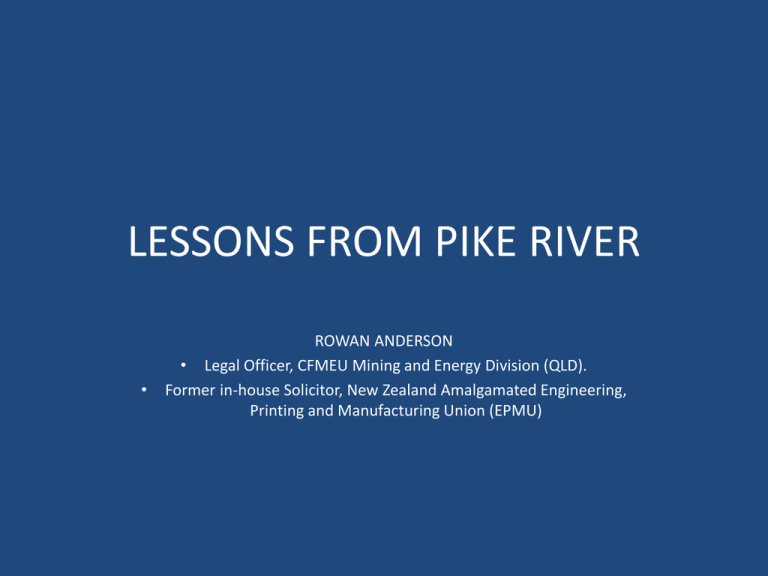
LESSONS FROM PIKE RIVER • ROWAN ANDERSON • Legal Officer, CFMEU Mining and Energy Division (QLD). Former in-house Solicitor, New Zealand Amalgamated Engineering, Printing and Manufacturing Union (EPMU) LESSONS FROM PIKE RIVER 1. 2. 3. 4. Background Pike River Report of the Royal Commission Legislative and regulatory reform History of disaster • • • • • • • Kaitangata (1879) 34, methane explosion Brunner (1896) 65, coal dust explosion Ralph’s Mine (1914) 43, gas explosion Strongman (1967) 19, explosion Boatman #4 (1985) 4, carbon monoxide Mt Davy (1998) 2, gas outburst Pike River (2010) 29, methane explosion Regulation • First industry specific regulation – Regulation of Mines Act 1874 • Lapsed 1897 • Rudimentary but provided for: – Two means of egress – Ventilation – Mines inspection Regulation… • Coal Mines Act 1886 – Followed Kaitangata disaster – Certification of mine managers – Inspection of mines by representatives of coal miners – Right to refuse unsafe work – Rebuttable presumption that accidents result from negligence of owners and managers – Prosecution of owners and managers Regulatory developments - 1925 • • • • • Coal Mines Act 1925 Separate inspectorate Appointment of Chief Inspectors Minimum experience requirements Provision of up to date mine plans Coal Mines Act 1979 • • • • • Prescriptive regulation Separate coal mines inspectorate Worker inspections Workman’s National Inspector Represented the “high tide” of regulation in New Zealand • The result of at least 10 Royal Commissions or Commissions of Inquiry Health and Safety in Employment Act 1992 • Robens approach without mandatory worker participation • Lack of tripartite oversight • “all practicable steps” • Industry specific regulation – 1996 and 1998 • Codes of practice – not developed (ACOP) • 2002 amendments to facilitate employee participation Other issues • Inspectorate • Inspectorate transferred to Department of Labour 1998 • Only one qualified inspector for underground coal mines. • Generalised approach, lack of resourcing and industry knowledge • Mine Safety Review (2006 – 2009) • Union push for reintroduction of check inspectors • Strengthening of regulations supported widely (COP’s) • Change of government November 2008 Coal Industry 2010 • Slightly over 5 million tonnes (compare Australia approximately 500 million tonnes) • 4 million tonnes from open-cut (16 mines) • Remainder from 5 underground operations • Approximately 1500 workers directly engaged in production PIKE RIVER Underground Significant issues • Location and access (licence to develop granted in 1997) • Inadequate geological information * Drift development delays and costs * Shaft collapse (2009) • Underfinancing for development * Grossly optimistic presentation * IPO – capital raising 4th occasion at November 2010 * several hundred $million, coal boom * Production pressure Continued • • • • • • Main fan placement Ratio of ‘clean skins’ Management turnaround Prototype equipment Inadequate ventilation Methane The Inspectorate • • • • • • • Lack of resource Reporting structures problematic No Chief Inspector DOL policies on enforcement - negotiation Regulation inadequate No worker engagement Company views unchallenged Tag-board: The 29 Royal Commission • Announced in weeks following disaster • Appointments – Justice Graham Pankhurst (Chair), High Court Judge – Stewart Bell, Commissioner for Mine Safety and Health (QLD) – David Henry, Former Commissioner of Inland Revenue… Royal Commission • Terms of reference – December 2010 – Cause – Practices used – Search, rescue and recovery – Regulatory requirements – Implementation of laws and resourcing Royal Commission • 11 weeks of hearings between July 2011 and April 2012. • 4 ‘phases’ – Context – Search and rescue – What happened at Pike River? – Policy aspects Royal Commission • Report back – 30 October 2012 • 16 primary recommendations – Regulatory framework – Statutory responsibilities – Approved code of practice – Worker participation – Emergency management – Mines Rescue Service Regulatory Framework • Expert task force • QLD and NSW as best practice • Specific Issues: – Removal of “all practicable steps” from mandatory requirements in regulations – Statutory positions (including ventilation officer) – Requirements for gas monitoring and ventilation – Prohibiting placement of main fans underground New Crown Agent • Sole focus on H&S • Responsibility for administering H&S • “High Hazards Unit” (late 2011) – Chief Inspector – Three Inspectors – Greater resourcing and inspectorate functions Worker Participation • Requirement for operators to have systems in place • Trained worker H&S Representatives – Perform inspections – Stop activities if immediate harm • Union Check Inspectors • Inspectors to routinely consult workers • ACOP Lost opportunity • Exclusion of tunnels and quarries • Work Safe Board – not tripartite • Over emphasis on ‘checks and balances’ on SSHR’s and ISHR’s • ISHR – Limited to underground coal Questions
